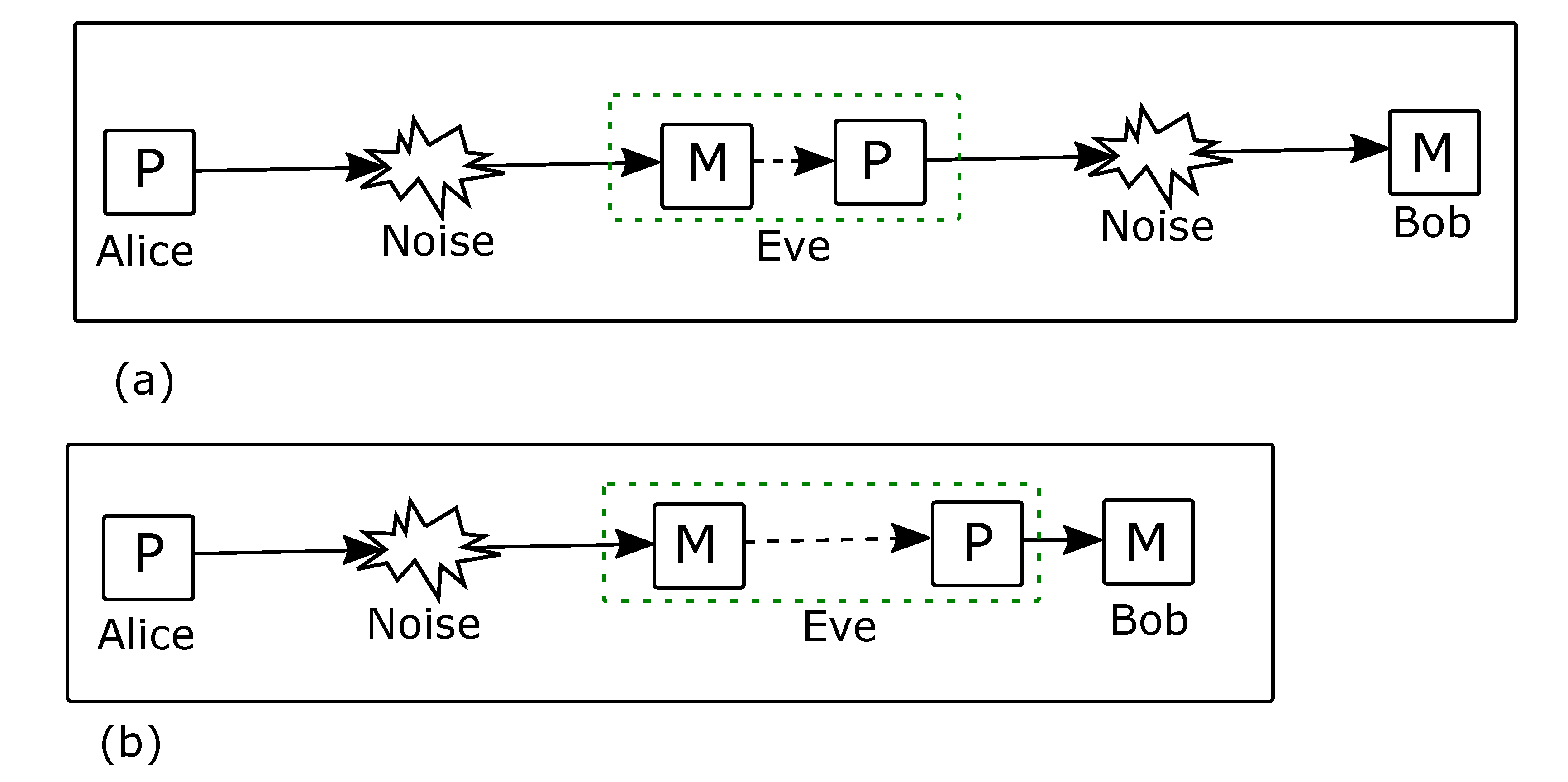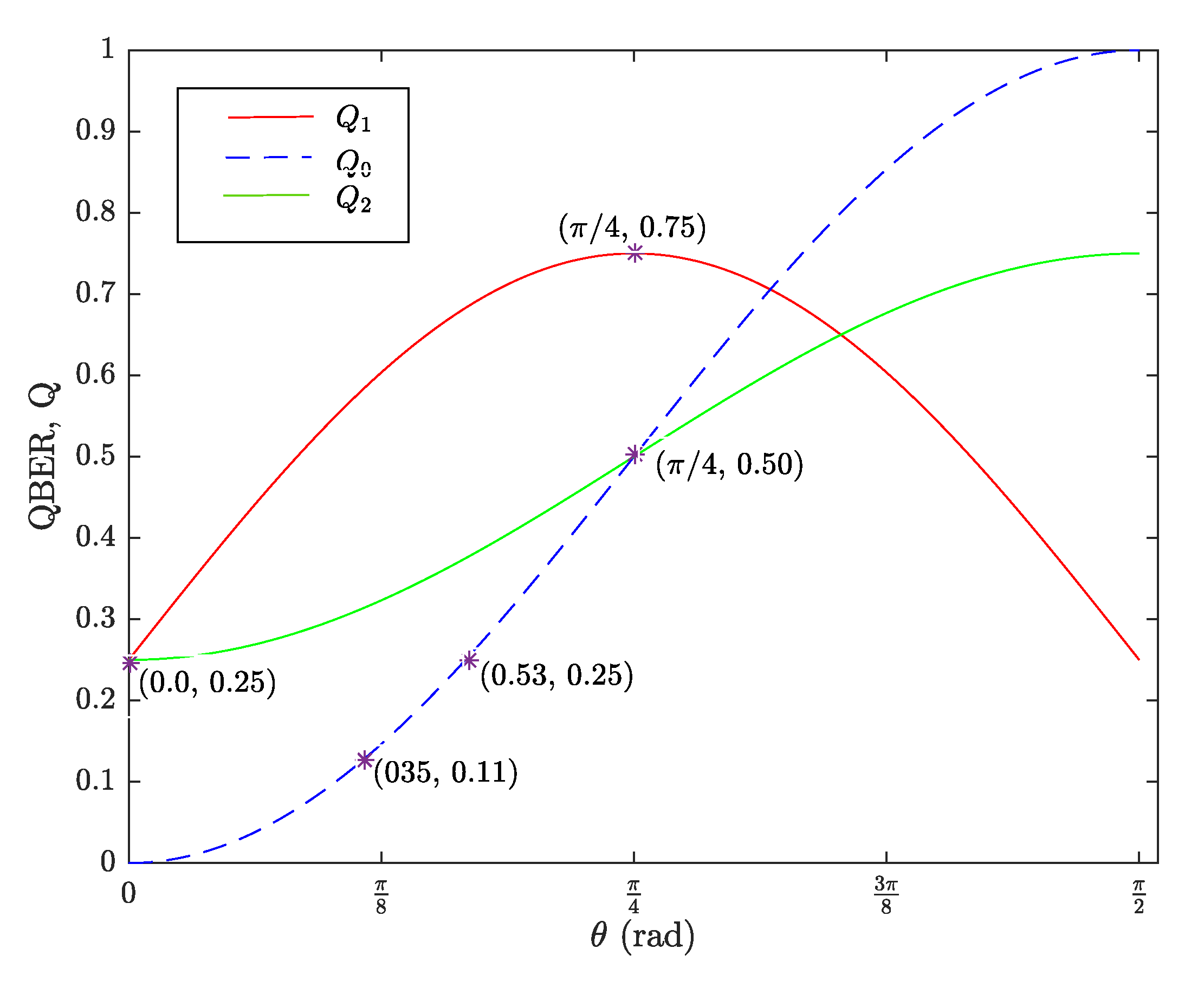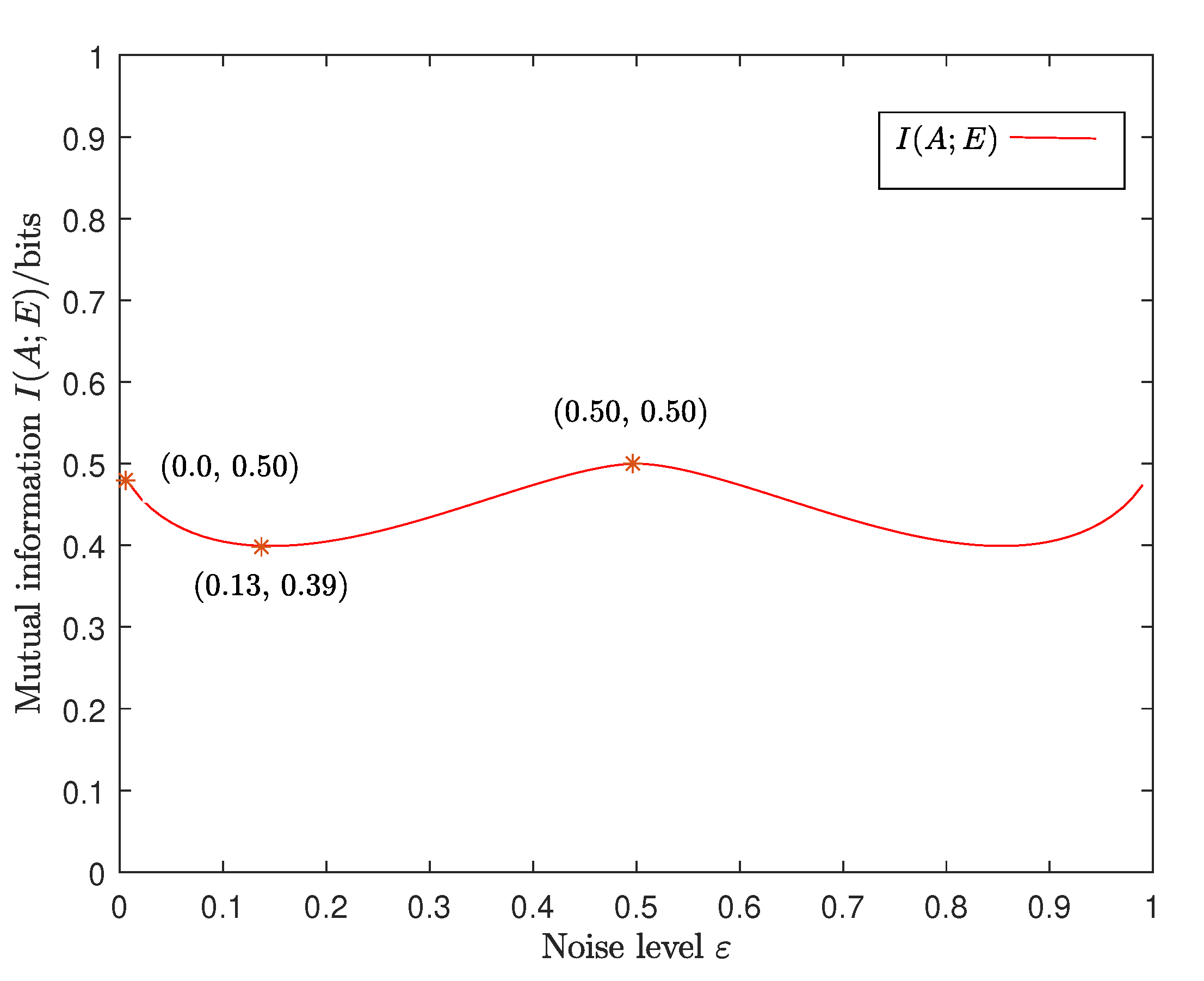Security of Bennett–Brassard 1984 Quantum-Key Distribution under a Collective-Rotation Noise Channel
Abstract
:1. Introduction
2. Operation of the BB84 Protocol
2.1. Preparation and Measurement
2.2. Parameter Estimation
2.3. Sifting
2.4. Key Map
2.5. Error Correction
2.6. Privacy Amplification
3. Collective-Rotation Noise
4. Security Analysis of the Intercept-and-Resend Attack
5. Conclusions
Author Contributions
Funding
Institutional Review Board Statement
Informed Consent Statement
Data Availability Statement
Conflicts of Interest
References
- Bennett, C.H.; Brassard, G. Quantum cryptography. Theor. Comput. Sci. 2014, 560, 7–11. [Google Scholar] [CrossRef]
- Gisin, N.; Ribordy, G.; Tittel, W.; Zbinden, H. Quantum cryptography. Rev. Mod. Phys. 2002, 74, 145. [Google Scholar] [CrossRef] [Green Version]
- Pirola, S.; Andersen, U.L.; Banchi, L.; Berta, M.; Bunar, D.; Colbeck, R.; Englund, D.; Gehring, T.; Lupo, C.; Ottaviani, C.; et al. Advances in quantum cryptography. Adv. Opt. Photonics 2020, 12, 1012–1236. [Google Scholar]
- Scarani, V.; Kurtsiefer, C. The black paper of quantum cryptography: Real implementation problems. Theor. Comput. Sci. 2014, 560, 27–32. [Google Scholar] [CrossRef]
- Kumar, A.; Garhwal, S. State-of-the-art survey of quantum cryptography. Arch. Comput. Methods Eng. 2021, 28, 1–38. [Google Scholar] [CrossRef]
- Hwang, W.Y. Quantum key distribution with high loss: Toward global secure communication. Phys. Rev. Lett. 2003, 91, 057901. [Google Scholar] [CrossRef] [Green Version]
- Zoller, P.; Beth, T.; Binosi, D.; Blatt, R.; Briegel, H.; Bruss, D.; Calarco, T.; Cirac, J.I.; Deutsch, D.; Eisert, J.; et al. Quantum information processing and communication. Eur. Phys. J. D. 2005, 36, 203–228. [Google Scholar] [CrossRef] [Green Version]
- Śliwczyński, Ł.; Krehlik, P.; Lipiński, M. Optical fibers in time and frequency transfer. Meas. Sci. Technol. 2010, 21, 075302. [Google Scholar] [CrossRef]
- Ngabireng, C.; Ambomo, S.; Dinda, P.T.; Moubissi, A. Loss effects in the spectra of polarization modulational instability in weakly birefringent optical fibers. J. Opt. 2011, 13, 085201. [Google Scholar] [CrossRef]
- Yang, C.W.; Hwang, T. Quantum dialogue protocols immune to collective noise. Quantum Inf. Process. 2013, 12, 2131–2142. [Google Scholar] [CrossRef]
- Mertz, M.; Kampermann, H.; Shadman, Z.; Bruß, D. Quantum key distribution with finite resources: Taking advantage of quantum noise. Phys. Rev. A 2013, 87, 042312. [Google Scholar] [CrossRef]
- Bruß, D. Optimal eavesdropping in quantum cryptography with six states. Phys. Rev. Lett. 1998, 81, 3018. [Google Scholar] [CrossRef] [Green Version]
- Senekane, M.; Mafu, M.; Petruccione, F. Six-state symmetric quantum key distribution protocol. J. Quant. Inf. Sci. 2015, 5, 33. [Google Scholar] [CrossRef] [Green Version]
- Scarani, V.; Acin, A.; Ribordy, G.; Gisin, N. Quantum cryptography protocols robust against photon number splitting attacks for weak laser pulse implementations. Phys. Rev. Lett. 2004, 92, 57901. [Google Scholar] [CrossRef] [Green Version]
- Lim, C.C.W.; Curty, M.; Walenta, N.; Xu, F.; Zbinden, H. Concise security bounds for practical decoy-state quantum key distribution. Phys. Rev. A 2014, 89, 022307. [Google Scholar] [CrossRef] [Green Version]
- Ralph, T.C. Continuous variable quantum cryptography. Phys. Rev. A 1999, 61, 010303. [Google Scholar] [CrossRef] [Green Version]
- Hillery, M. Quantum cryptography with squeezed states. Phys. Rev. A 2000, 61, 022309. [Google Scholar] [CrossRef] [Green Version]
- Aguiar, L.D.S.; Borelli, L.F.; Roversi, J.A.; Vidiella-Barranco, A. Performance analysis of continuous-variable quantum key distribution using non-Gaussian states. Quantum Inf. Process. 2022, 21, 1–15. [Google Scholar] [CrossRef]
- Inoue, K.; Waks, E.; Yamamoto, Y. Differential phase shift quantum key distribution. Phys. Rev. Lett. 2002, 89, 037902. [Google Scholar] [CrossRef]
- Stucki, D.; Brunner, N.; Gisin, N.; Scarani, V.; Zbinden, H. Fast and simple one-way quantum key distribution. Appl. Phys. Lett. 2005, 87, 194108. [Google Scholar] [CrossRef] [Green Version]
- Mafu, M.; Marais, A.; Petruccione, F. A necessary condition for the security of coherent-one-way quantum key distribution protocol. Appl. Math. Inf. Sci. 2014, 8, 2769. [Google Scholar] [CrossRef]
- Grosshans, F.; Van Assche, G.; Wenger, J.; Brouri, R.; Cerf, N.J.; Grangier, P. Quantum key distribution using gaussian-modulated coherent states. Nature 2003, 421, 238–241. [Google Scholar] [CrossRef] [PubMed] [Green Version]
- Laudenbach, F.; Pacher, C.; Fung, C.H.F.; Poppe, A.; Peev, M.; Schrenk, B.; Hübel, H. Continuous-Variable quantum key distribution with gaussian modulation—The theory of practical implementations. Adv. Quantum Technol. 2018, 1, 1870011. [Google Scholar] [CrossRef]
- Pironio, S.; Acín, A.; Brunner, N.; Gisin, N.; Massar, S.; Scarani, V. Device-independent quantum key distribution secure against collective attacks. N. J. Phys. 2009, 11, 045021. [Google Scholar] [CrossRef]
- Woodhead, E.; Acín, A.; Pironio, S. Device-independent quantum key distribution with asymmetric CHSH inequalities. Quantum 2021, 5, 443. [Google Scholar] [CrossRef]
- Zhao, W.; Shi, R.; Ruan, X.; Guo, Y.; Mao, Y.; Feng, Y. Monte Carlo-based security analysis for multi-mode continuous-variable quantum key distribution over underwater channel. Quantum Inf. Process. 2022, 21, 1–14. [Google Scholar] [CrossRef]
- Curty, M.; Xu, F.; Cui, W.; Lim, C.C.W.; Tamaki, K.; Lo, H.K. Finite-key analysis for measurement-device-independent quantum key distribution. Nat. Commun. 2014, 5, 1–7. [Google Scholar] [CrossRef] [Green Version]
- Lo, H.K.; Curty, M.; Qi, B. Measurement-device-independent quantum key distribution. Phys. Rev. Lett. 2012, 108, 130503. [Google Scholar] [CrossRef] [PubMed] [Green Version]
- Zhou, Y.H.; Qin, S.F.; Shi, W.M.; Yang, Y.G. Measurement-device-independent continuous variable semi-quantum key distribution protocol. Quant. Inf. Process. 2022, 21, 1–21. [Google Scholar] [CrossRef]
- Sibson, P.; Erven, C.; Godfrey, M.; Miki, S.; Yamashita, T.; Fujiwara, M.; Thompson, M.G. Chip-based quantum key distribution. Nat. Comm. 2017, 8, 1–6. [Google Scholar] [CrossRef] [PubMed] [Green Version]
- Semenenko, H.; Sibson, P.; Hart, A.; Thompson, M.G.; Rarity, J.G.; Erven, C. Chip-based measurement-device-independent quantum key distribution. Optica 2020, 7, 238–242. [Google Scholar] [CrossRef]
- Kwek, L.C.; Cao, L.; Luo, W.; Wang, Y.; Sun, S.; Wang, X.; Liu, A.Q. Chip-based quantum key distribution. AAPPS Bull. 2021, 31, 1–8. [Google Scholar] [CrossRef]
- Zhao, P.; Zhou, L.; Zhong, W.; Sheng, Y.B. Faithful entanglement distribution using quantum multiplexing in noisy channel. Eur. Lett. 2021, 135, 40001. [Google Scholar] [CrossRef]
- Liu, Q.; Huang, Y.; Du, Y.; Zhao, Z.; Geng, M.; Zhang, Z.; Wei, K. Advances in chip-based quantum key distribution. Entropy 2022, 24, 1334. [Google Scholar] [CrossRef]
- Orieux, A.; Diamanti, E. Recent advances on integrated quantum communications. J. Opt. 2016, 18, 083002. [Google Scholar] [CrossRef] [Green Version]
- Tamaki, K.; Lütkenhaus, N. Unconditional security of the Bennett 1992 quantum key-distribution protocol over a lossy and noisy channel. Phys. Rev. A 2004, 69, 032316. [Google Scholar] [CrossRef] [Green Version]
- Wang, X.B. Fault tolerant quantum key distribution protocol with collective random unitary noise. Phys. Rev. A 2005, 72, 050304. [Google Scholar] [CrossRef] [Green Version]
- Grasselli, F.; Kampermann, H.; Bruß, D. Finite-key effects in multipartite quantum key distribution protocols. N. J. Phys. 2018, 20, 113014. [Google Scholar] [CrossRef]
- Zhang, Z.J. Robust multiparty quantum secret key sharing over two collective-noise channels. Phys. A: Stat. Mech. Appl. 2006, 361, 233–238. [Google Scholar] [CrossRef]
- Li, X.H.; Deng, F.G.; Zhou, H.Y. Efficient quantum key distribution over a collective noise channel. Phys. Rev. A 2008, 78, 022321. [Google Scholar] [CrossRef] [Green Version]
- Dong, L.; Xiu, X.M.; Gao, Y.J.; Chi, F. Deterministic secure quantum communication against collective-dephasing noise by using EPR pairs and auxiliary photons. Opt. Commun. 2009, 282, 1688–1690. [Google Scholar] [CrossRef]
- Xiu, X.M.; Dong, L.; Gao, Y.J.; Chi, F. Quantum key distribution protocols with six-photon states against collective noise. Opt. Commun. 2009, 282, 4171–4174. [Google Scholar] [CrossRef]
- Sheng, Y.B.; Deng, F.G. Efficient quantum entanglement distribution over an arbitrary collective-noise channel. Phys. Rev. A 2010, 81, 042332. [Google Scholar] [CrossRef] [Green Version]
- Dong, H.K.; Dong, L.; Xiu, X.M.; Gao, Y.J. A deterministic secure quantum communication protocol through a collective rotation noise channel. Int. J. Quantum Inf. 2010, 8, 1389–1395. [Google Scholar] [CrossRef]
- Huang, W.; Wen, Q.; Liu, B.; Gao, F.; Sun, Y. Robust and efficient quantum private comparison of equality with collective detection over collective-noise channels. Sci. China Phys. Mech. 2013, 56, 1670–1678. [Google Scholar] [CrossRef]
- Gu, B.; Zhang, C.; Cheng, G.; Huang, Y. Robust quantum secure direct communication with a quantum one-time pad over a collective-noise channel. Sci. China Physics, Mech. Astron. 2011, 54, 942–947. [Google Scholar] [CrossRef]
- Yang, C.; Tsai, C.; Hwang, T. Fault tolerant two-step quantum secure direct communication protocol against collective noises. Sci. China Phys. Mech. 2011, 54, 496–501. [Google Scholar] [CrossRef]
- Wei, H.; Qiao-Yan, W.; Heng-Yue, J.; Su-Juan, Q.; Fei, G. Fault tolerant quantum secure direct communication with quantum encryption against collective noise. Chin. Phys. B 2012, 21, 100308. [Google Scholar]
- Ye, T. Fault tolerant channel-encrypting quantum dialogue against collective noise. Sci. China Phys. Mech. 2015, 58, 1–10. [Google Scholar] [CrossRef]
- Ye, T.Y. Quantum secure direct dialogue over collective noise channels based on logical Bell states. Quantum Inf. Process. 2015, 14, 1487–1499. [Google Scholar] [CrossRef]
- Li, J.; Pan, Z.; Zheng, J.; Sun, F.; Ye, X.; Yuan, K. The security analysis of quantum SAGR04 protocol in collective-rotation noise channel. Chin. J. Electron. 2015, 24, 689–693. [Google Scholar] [CrossRef]
- Wu, L.; Chen, Y. Three stage quantum cryptography protocol under collective-rotation noise. Entropy 2015, 17, 2919–2931. [Google Scholar] [CrossRef]
- Garapo, K.; Mafu, M.; Petruccione, F. Intercept-resend attack on six-state quantum key distribution over collective-rotation noise channels. Chin. Phys. B 2016, 25, 070303. [Google Scholar] [CrossRef]
- Li, L.; Li, J.; Li, C.; Li, H.; Yang, Y.; Chen, X. The security analysis of quantum B92 protocol in collective-rotation noise channel. Int. J. Theor. Phys. 2019, 58, 1326–1336. [Google Scholar] [CrossRef]
- Yang, Y.G.; Gao, S.; Li, D.; Zhou, Y.H.; Shi, W.M. Three-party quantum secret sharing against collective noise. Quantum Inf. Process. 2019, 18, 1–11. [Google Scholar] [CrossRef]
- He, Y.F.; Ma, W.P. Multiparty quantum secure direct communication immune to collective noise. Quantum Inf. Process. 2019, 18, 1–11. [Google Scholar] [CrossRef]
- Chang, L.W.; Zhang, Y.Q.; Tian, X.X.; Qian, Y.H.; Zheng, S.H. Fault tolerant controlled quantum dialogue against collective noise. Chin. Phys. B 2020, 29, 010304. [Google Scholar] [CrossRef]
- Zhao, J.; Zhang, W.; Ma, Y.; Zhang, X.; Ma, H. Development of quantum private queries protocol on collective-dephasing noise channel. Appl. Sci. 2020, 10, 1935. [Google Scholar] [CrossRef] [Green Version]
- Waks, E.; Zeevi, A.; Yamamoto, Y. Security of quantum key distribution with entangled photons against individual attacks. Phys. Rev. A 2002, 65, 052310. [Google Scholar] [CrossRef] [Green Version]
- Żukowski, M.; Zeilinger, A.; Horne, M.A.; Ekert, A.K. "Event-ready-detectors" Bell experiment via entanglement swapping. Phys. Rev. Lett. 1993, 71, 4287–4290. [Google Scholar] [CrossRef]
- Gu, B.; Pei, S.; Song, B.; Zhong, K. Deterministic secure quantum communication over a collective-noise channel. Sci. China Phys. Mech. 2009, 52, 1913–1918. [Google Scholar] [CrossRef]
- Li, J.; Chen, Y.H.; Pan, Z.S.; Sun, F.Q.; Li, N.; Li, L.L. Security analysis of BB84 protocol in the collective-rotation noise channel. Acta Phys. Sin. 2016, 65, 30302. [Google Scholar]
- Curty, M.; Lütkenhaus, N. Intercept-resend attacks in the Bennett-Brassard 1984 quantum-key-distribution protocol with weak coherent pulses. Phys. Rev. A 2005, 71, 062301. [Google Scholar] [CrossRef]



| Alice Sends | Eve Obtains | |||
|---|---|---|---|---|
| |0〉 | |1〉 | |+〉 | |−〉 | |
| Eve Sends | Bob Obtains | |||
|---|---|---|---|---|
| |0〉 | |1〉 | |+〉 | |−〉 | |
| Alice Sends | Bob Receives | |||
| |0〉 | |1〉 | |+〉 | |−〉 | |
| a | b | c | d | |
| b | a | d | c | |
| d | c | a | b | |
| c | d | b | a | |
Publisher’s Note: MDPI stays neutral with regard to jurisdictional claims in published maps and institutional affiliations. |
© 2022 by the authors. Licensee MDPI, Basel, Switzerland. This article is an open access article distributed under the terms and conditions of the Creative Commons Attribution (CC BY) license (https://creativecommons.org/licenses/by/4.0/).
Share and Cite
Mafu, M.; Sekga, C.; Senekane, M. Security of Bennett–Brassard 1984 Quantum-Key Distribution under a Collective-Rotation Noise Channel. Photonics 2022, 9, 941. https://doi.org/10.3390/photonics9120941
Mafu M, Sekga C, Senekane M. Security of Bennett–Brassard 1984 Quantum-Key Distribution under a Collective-Rotation Noise Channel. Photonics. 2022; 9(12):941. https://doi.org/10.3390/photonics9120941
Chicago/Turabian StyleMafu, Mhlambululi, Comfort Sekga, and Makhamisa Senekane. 2022. "Security of Bennett–Brassard 1984 Quantum-Key Distribution under a Collective-Rotation Noise Channel" Photonics 9, no. 12: 941. https://doi.org/10.3390/photonics9120941





